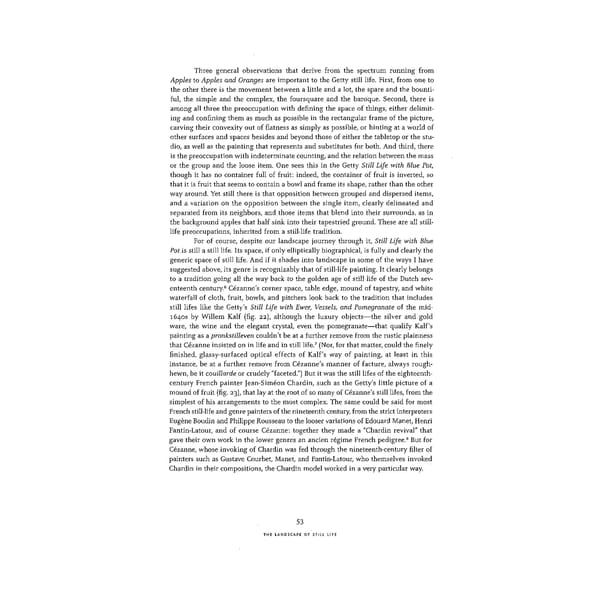Three general observations that derive from the spectrum running from Apples to Apples and Oranges are important to the Getty still life. First, from one to the other there is the movement between a little and a lot, the spare and the bounti- ful, the simple and the complex, the foursquare and the baroque. Second, there is among all three the preoccupation with defining the space of things, either delimit- ing and confining them as much as possible in the rectangular frame of the picture, carving their convexity out of flatness as simply as possible, or hinting at a world of other surfaces and spaces besides and beyond those of either the tabletop or the stu- dio, as well as the painting that represents and substitutes for both. And third, there is the preoccupation with indeterminate counting, and the relation between the mass or the group and the loose item. One sees this in the Getty Still Life with Blue Pot, though it has no container full of fruit: indeed, the container of fruit is inverted, so that it is fruit that seems to contain a bowl and frame its shape, rather than the other way around. Yet still there is that opposition between grouped and dispersed items, and a variation on the opposition between the single item, clearly delineated and separated from its neighbors, and those items that blend into their surrounds, as in the background apples that half sink into their tapestried ground. These are all still- life preoccupations, inherited from a still-life tradition. For of course, despite our landscape journey through it, Still Life with Blue Pot is still a still life. Its space, if only elliptically biographical, is fully and clearly the generic space of still life. And if it shades into landscape in some of the ways I have suggested above, its genre is recognizably that of still-life painting. It clearly belongs to a tradition going all the way back to the golden age of still life of the Dutch sev- enteenth century.6 Cezanne's corner space, table edge, mound of tapestry, and white waterfall of cloth, fruit, bowls, and pitchers look back to the tradition that includes still lifes like the Getty's Still Life with Ewer, Vessels, and Pomegranate of the mid- 16405 by Willem Kalf (fig. 22), although the luxury objects—the silver and gold ; ware, the wine and the elegant crystal, even the pomegranate—that qualify Kalf s painting as a pronkstilleven couldn't be at a further remove from the rustic plainness 7 that Cézanne insisted on in life and in still life. (Nor, for that matter, could the finely finished, glassy-surfaced optical effects of Kalf's way of painting, at least in this instance, be at a further remove from Cezanne's manner of facture, always rough- hewn, be it couillarde or crudely "faceted.") But it was the still lifes of the eighteenth- century French painter Jean-Siméon Chardin, such as the Getty's little picture of a mound of fruit (fig. 23), that lay at the root of so many of Cezanne's still lifes, from the simplest of his arrangements to the most complex. The same could be said for most French still-life and genre painters of the nineteenth century, from the strict interpreters Eugène Boudin and Philippe Rousseau to the looser variations of Edouard Manet, Henri Fantin-Latour, and of course Cézanne: together they made a "Chardin revival" that gave their own work in the lower genres an ancien régime French pedigree.8 But for Cézanne, whose invoking of Chardin was fed through the nineteenth-century filter of painters such as Gustave Courbet, Manet, and Fantin-Latour, who themselves invoked Chardin in their compositions, the Chardin model worked in a very particular way. 53 THE LANDSCAPE OF STILL LIFE
 Cézanne in the Studio: Still Life in Watercolors Page 67 Page 69
Cézanne in the Studio: Still Life in Watercolors Page 67 Page 69